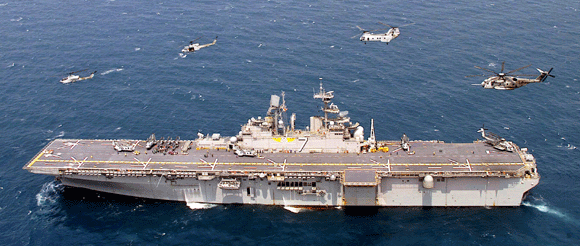Seabasing became a hot topic this past decade. It is portrayed as a revolutionary idea that allows a light logistical "footprint" by employing just-in-time logistical support. The idea is that an amphibious or expeditionary force need not establish huge stocks of supplies ashore if it can draw whatever it needs from well-organized ships offshore. This is an attractive idea because it eliminates the need to establish stockpiles and fuel farms ashore, facilities for their workers, and security for all.
This seems brilliant, so why didn't the experts of previous wars discover seabasing? First, sealift is finite and armies usually have many times more tonnage to move than sealift. Therefore, they "stage" near an objective area, then use their limited sealift to shuttle these resources after a surprise landing. If ships must linger offshore to provide seabased support, they are unavailable to shuttle supplies from staging areas. Second, a seaborne landing quickly attracts the attention of enemy commanders who vector their ships, attack boats, missiles, submarines, commandos, and attack aircraft toward that area. It is much safer for a ship to off-load cargo and depart rather than loiter offshore like a duck in a shooting gallery. Moreover, supplies ashore cannot be sunk by a single torpedo or missile. Since many ships are filled with explosive fuel and ammo, ship captains are likely to run at the first sign of an enemy threat.
 Third, while rapidly moving supplies from ships to shore on demand seems simple,
the
"fog of war" may intervene. Bad weather or over-the-horizon
communications may leave troops stranded ashore without food and ammo.
Ships, helicopters, and landing craft break down while naval forces are
often distracted by other naval priorities. Even an unsophisticated enemy
can fire a modern homing torpedo from a fishing boat
and sink a big ship, causing the Navy commander to order all ships to
leave an area. During World War II, warships from the Japanese Navy approached
Guadalcanal where US Marines had landed several days before. The US Navy
decided to run than fight, taking along cargo ships that were unloading supplies to
Marines ashore. The Marines survived on the supplies that had been off-loaded, yet they would call
today's seabasing idea insane.
Third, while rapidly moving supplies from ships to shore on demand seems simple,
the
"fog of war" may intervene. Bad weather or over-the-horizon
communications may leave troops stranded ashore without food and ammo.
Ships, helicopters, and landing craft break down while naval forces are
often distracted by other naval priorities. Even an unsophisticated enemy
can fire a modern homing torpedo from a fishing boat
and sink a big ship, causing the Navy commander to order all ships to
leave an area. During World War II, warships from the Japanese Navy approached
Guadalcanal where US Marines had landed several days before. The US Navy
decided to run than fight, taking along cargo ships that were unloading supplies to
Marines ashore. The Marines survived on the supplies that had been off-loaded, yet they would call
today's seabasing idea insane.
On the other hand, seabasing is ideal for counterinsurgency operations. Large armies have a dismal track record fighting insurgencies. They build massive facilities ashore and hire locals to perform menial labor. Some of these workers are sympathetic to insurgents and provide them excellent intelligence and help coordinate attacks on facilities and their supply lines. In addition, foreign troops often infuriate local people with ignorance of local customs, routine accidents, and problems caused by alcohol abuse and sexual attraction to local women. This helps insurgents portray their government as a puppet of evil foreigners.
Seabasing eliminates all these problems. Small combat units can deploy from amphibious ships by helicopter or landing craft to hunt insurgents for a few days at a time, then return to the ship for several days for hot showers, hot chow, and other support needs. After several weeks, their ship can depart the area to a distant friendly port for supplies and recreation. As a result, local people have little contact with foreign troops, while insurgents become demoralized as they are hunted down. They have no chance to strike back as ships offshore are too distant to attack and their intel on enemy operations is nonexistent.
Seabasing is also a great idea for support elements, like: hospital ships, liberty ships, bunker barges, and maintenance ships. These are not transports, but support activities that are safer and more effective "port basing" e.g. tying up portside or anchoring in a safe bay. Seabasing is a good idea for counterinsurgencies, amphibious raids, and service support functions, yet it is an impractical and dangerous logistical concept for major operations.
©2015 www.G2mil.com